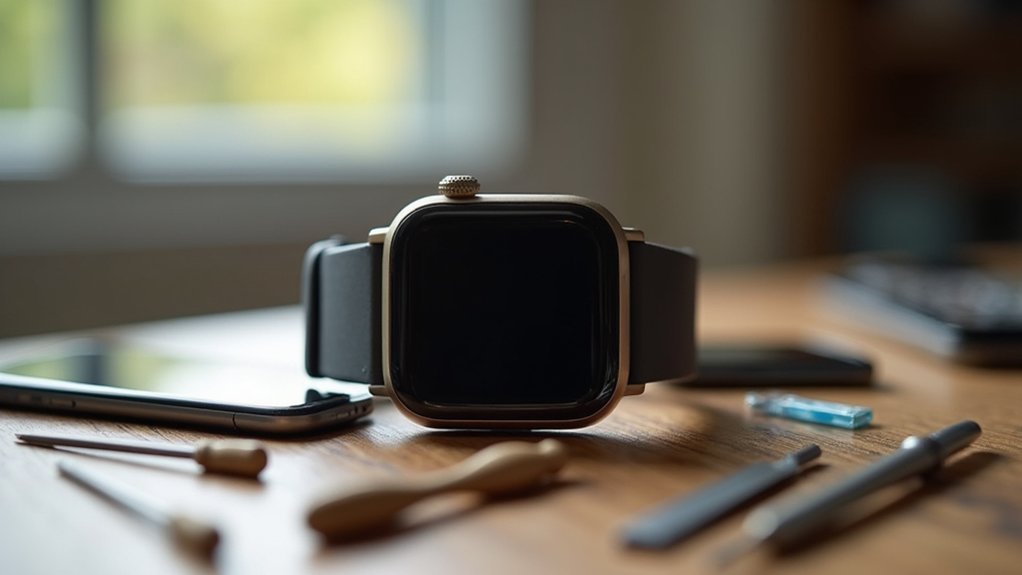To fix GPS drift on your running watch: 1) Position your watch with clear sky visibility, away from buildings and electronic devices. 2) Update your firmware regularly and allow a full GPS lock before starting your run. 3) Switch from Smart to Every Second recording mode for more accurate tracking. These simple adjustments can dramatically improve your watch’s accuracy, especially on challenging trails where precision matters most.
Optimal Smartwatch Positioning for Maximum GPS Signal Clarity

While many runners blame their smartwatch for inaccurate tracking, proper positioning of your device can dramatically improve GPS signal clarity.
Position your watch on your wrist so it’s not obstructed by clothing or other objects. Maintain a clear line of sight between your watch and the sky to enhance satellite connectivity.
Keep your watch visible to the sky, free from sleeves or obstructions, for optimal GPS tracking.
Avoid areas with tall buildings, dense tree cover, or mountainous terrain that block signals. This “urban canyon effect” is a common cause of GPS drift.
During runs in crowded areas, keep your watch away from other electronic devices to minimize interference.
If you’re running in adverse weather conditions like heavy rain or fog, you may need to adjust your expectations for signal quality.
Secure your watch firmly on your wrist to prevent movement that could impact signal reception. Consider performing a GPS soak for two minutes after your watch indicates GPS ready to improve tracking accuracy.
Essential Software Updates and Device Calibration Practices
Beyond proper positioning of your smartwatch, keeping your software up-to-date plays a major role in minimizing GPS drift issues. Regularly update your watch’s firmware through Garmin Connect or Garmin Express to fix bugs and improve GPS performance.
For ideal calibration, allow your watch to achieve a GPS lock and “soak” for five minutes before starting your activity. Consider switching data recording from Smart to Every Second mode for more precise distance measurements. Remaining stationary while acquiring signals helps ensure optimal satellite connection before you begin your run.
When in urban areas, select GPS + Galileo satellite networks, which offer better signal penetration around buildings.
If you notice persistent issues, restart your watch and wait two hours before manual syncing to refresh system processes.
Remember to use the manual pause feature when stopped to prevent recording inaccurate distances during rest periods.
Leveraging Sensor Fusion for Enhanced Trail Running Accuracy

Trail running presents unique challenges for GPS accuracy that conventional satellite tracking alone can’t solve.
When you’re traversing dense forests or deep valleys, your watch’s ability to maintain accuracy depends heavily on sensor fusion technology.
Modern running watches combine data from GPS, accelerometers, gyroscopes, and magnetometers to track your movement even when satellite signals fade. This integration helps maintain reliable pace and distance metrics despite challenging terrain.
You’ll notice improved accuracy especially on switchbacks and under heavy tree cover where GPS traditionally struggles. Trail running conditions typically cause GPS accuracy to decline due to twists and terrain that confuse satellite tracking systems.
To maximize sensor fusion benefits, keep your watch’s firmware updated and perform occasional calibration.
The technology continuously improves through algorithmic advancements, with newer models achieving accuracy within 0.6-1.9% of actual distance—even in the most demanding trail conditions.
Frequently Asked Questions
Does GPS Drift Affect Battery Life on My Running Watch?
Yes, GPS drift does affect your watch’s battery life. When your device struggles with weak signals or interference, it works harder to maintain accuracy, draining your battery faster than during ideal conditions.
Can Weather Conditions Impact GPS Accuracy During Runs?
Yes, weather conditions can impact your GPS accuracy. Cloud cover, rain, and snow may slightly reduce signal strength. High humidity can weaken signals, while extreme temperatures might affect your watch’s battery performance during runs.
How Often Should I Reset My GPS Watch?
You don’t need to reset your GPS watch regularly. Only reset when you experience persistent issues like freezing, GPS problems, or after software updates. Usually, a simple restart will resolve minor glitches.
Why Does GPS Drift Occur More in Cities Than Countryside?
You’ll experience more GPS drift in cities because tall buildings block and reflect satellite signals. Urban canyons create multipath errors, while electronic interference from city infrastructure further degrades GPS accuracy compared to open countryside.
Can GPS Drift Cause Incorrect Elevation Gain Readings?
Yes, GPS drift can greatly affect your elevation gain readings. When your watch’s GPS signal fluctuates, it creates phantom ups and downs that don’t exist, sometimes adding hundreds of feet to your total elevation gain.
In Summary
By placing your watch correctly, keeping software current, and calibrating regularly, you’ll transform your running data experience. Don’t forget to enable sensor fusion for those challenging trail runs where accuracy matters most. These simple fixes will guarantee your training metrics remain reliable, helping you track progress with confidence. Your runs deserve accurate data—now you’ll get it with every stride.





Leave a Reply